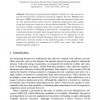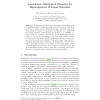ICWMC
2006
IEEE
14 years 6 months ago
2006
IEEE
Geographic routing in wireless sensor networks is based on the prerequisite that every node has information about its current position, for instance via GPS or some localization a...
GLOBECOM
2006
IEEE
14 years 6 months ago
2006
IEEE
Abstract— Controlling the topology of a wireless ad hoc network is very important from the point of view of performance. One known technique for controlling the topology is throu...
GLOBECOM
2006
IEEE
14 years 6 months ago
2006
IEEE
— This work presents a statistical field study of the availability of time sources for location in a true wireless network. Terrestrial (base stations) and satellite (GPS) source...
E2EMON
2006
IEEE
14 years 6 months ago
2006
IEEE
— For active, probing-based bandwidth measurements performed on top of the unifying IP layer, it may seem reasonable to expect the measurement problem in wireless networks to be ...
COMSWARE
2006
IEEE
14 years 6 months ago
2006
IEEE
—Most of the contemporary research in wireless networks is primarily based on simulations or in-house small scale experimental setups that are highly customized for the experimen...
COMSWARE
2006
IEEE
14 years 6 months ago
2006
IEEE
— Development in new radio technologies and increase in user demands are driving the deployment of a wide array of wireless networks, ranging from 802.11 networks in the local ar...
BROADNETS
2006
IEEE
14 years 6 months ago
2006
IEEE
Due to the shared medium nature of wireless networks, the uncertainties caused by collisions and interferences make the Quality of Service (QoS) issue harder than its wired counte...
WWIC
2007
Springer
14 years 6 months ago
2007
Springer
In this paper we present the distributed event localization and tracking algorithm DELTA that solely depends on light measurements. Based on this information and the positions of t...
WWIC
2007
Springer
14 years 6 months ago
2007
Springer
We propose a layered quality adaptation scheme for video streams to smooth the short-term oscillations induced by Additive Increase Multiplicative Decrease (AIMD) mechanisms, and e...
WWIC
2007
Springer
14 years 6 months ago
2007
Springer
In this paper, we introduce a cross-layer diversity framework for multi-air interface wireless communication devices. As an initial step, we focus on devices, of the cellular phone...




